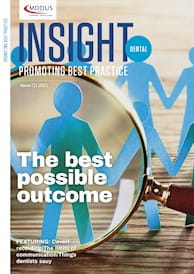 THE term ‘coronacoaster’ began life as a funny meme about fluctuating between the highs of mastering the “baking of banana bread” and the lows of “drinking gin for breakfast”. But it’s since become a way for individuals to describe the sometimes frightening emotional ups and downs of coping through the pandemic.
THE term ‘coronacoaster’ began life as a funny meme about fluctuating between the highs of mastering the “baking of banana bread” and the lows of “drinking gin for breakfast”. But it’s since become a way for individuals to describe the sometimes frightening emotional ups and downs of coping through the pandemic.
For many of us it struck a chord, giving a name to the experience and attributing a reasonable cause. It provided an easily recognisable concept – and language – with which to understand and share our own experiences with others over time.
Dental teams have been hugely impacted by the pandemic and are not exempt from the ups and downs of the coronacoaster experience. They are now better equipped to work in very different ways to ensure patients are looked after. But it is important that the longer-term effects on the team’s physical and mental wellbeing are recognised and managed day-to-day.
Safety risks
We know from the medical sector that there is a significant correlation between poor wellbeing and worse patient safety, as measured by administrative and clinical errors. There is also an association between burnout and patient safety outcomes.
In dental practice, there has been shown to be a link between burnout and early departure from the profession, an increase in physical and mental health problems, and a decline in professional standards*.
If individuals are experiencing a low point, it’s very likely that this will impact on their communication. At best, this could result in a patient complaint about lack of empathy/care, or a near miss where a procedure is not undertaken as it should. At worst, an urgent message to a colleague or patient could be forgotten and a crucial follow-up opportunity missed.
Differing lenses
Assuming we’re all on a metaphorical coaster right now, it’s important for practice owners, PMs and clinical leads to note that at the level of individual experience we’re not all on the same ride.
Some of us love rollercoasters. I’m one of them, mostly. I like the feeling of anticipation and excitement, and once the really scary bits are over I recover pretty quickly, left with a feeling of personal achievement.
Some of us do not love rollercoasters. They prefer being on solid ground, and the comfort that there is no chance they will come off the rails. Uncertainty, pressure and seeing changes in others’ emotions and behaviours can be scary.
When we are at a high point, we may all feel a little more in control, with a clear view of the way forward, but we may also be worried about what’s coming around the corner. For some, that corner or dark tunnel might appear more acute and longer lasting. In addition to our own personal and work worries, we might also be worrying about friends, family, childcare, financial matters or society itself. Some of us will have access to a stronger support structure – one that we can call upon in case of a “breakdown”.
So how can you tell if one of the team is in a tunnel, can’t see a safe way to step off, or is being weighed down by thoughts of what might come next?
Practical steps
In my mind, clinical and management leads can do two things.
1. Ensure that the working environment is as safe, secure and predictable as possible
Have clear and current policies in place on protective measures including:
- social distancing, PPE and infection control
- good clinical and non-clinical communication (particularly if teams are fragmented at the moment)
- what to do if staff have concerns about a patient or colleague
- employment and support arrangements if staff have to self-isolate.
2. Prioritise mental health and wellbeing
When we look at the reasons resilience is reduced, it’s more often non-clinical aspects of the work environment that are the cause – e.g. lack of support, poor communication or lack of respect. Some steps to take include:
- Check in with your colleagues regularly, whether it’s arranging one-to-ones or making sure everyone is attending and ‘visible’ at meetings. In remote meetings, it’s easy for a colleague to get lost or ‘hide’ if they don’t share a webcam at least some of the time.
- Create opportunities for positive engagement with each other. This can be difficult at the best of times but I’ve seen teams come up with creative ways to engage and build a little bit of fun, reward or positivity into people’s day. You may choose to order in some nice, individually packed treats (even better if they’re from local shops). Or consider undertaking a group charity challenge, then sharing your achievement with friends/the community.
- Make asking for help easy. Becoming withdrawn, having a shorter fuse and other similar behaviours all have the potential to reduce team effectiveness, increase error rates and spark unprofessional behaviours. Team members need to know how to ask for help. Speaking up at a time when everyone is under extreme pressure can be even more challenging when the team around you look like they are struggling too.
- Create a “safe space”. I recently came across a team who had become aware that they were not really listening to each other and concerns were being brushed aside without being properly considered. Minor issues began to accumulate and have an adverse impact both on individuals (and the way they were able to undertake their role within the team) and directly on patients. To address this, the leads created a safe space within the building, and a ‘permission protocol’. A colleague who needed to talk would approach one of a small group of volunteers who would commit to meeting with them in that safe space as soon as they were able to. While it has taken time to embed, the team is now reporting higher levels of perceived support and any issues – personal or clinical – can be identified and addressed at the early stages.
Even if you are the type of person who does like rollercoasters, sometimes it can get a little too scary. So take stock regularly, look out for colleagues and be sure to ask for help when you need it.
Liz Price is senior risk adviser at MDDUS
This page was correct at the time of publication. Any guidance is intended as general guidance for members only. If you are a member and need specific advice relating to your own circumstances, please contact one of our advisers.
Read more from this issue of Insight Dental

Save this article
Save this article to a list of favourite articles which members can access in their account.
Save to library